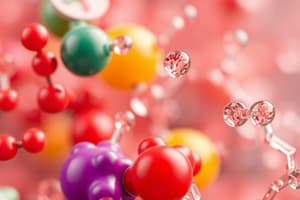Podcast
Questions and Answers
Enzymes are biological __________ that speed up chemical reactions in living organisms.
Enzymes are biological __________ that speed up chemical reactions in living organisms.
catalysts
Enzymes are protein molecules, which are made up of long chains of __________.
Enzymes are protein molecules, which are made up of long chains of __________.
amino acids
The sequence and type of amino acids are __________ in each protein.
The sequence and type of amino acids are __________ in each protein.
different
The shape of an enzyme is very important to its __________.
The shape of an enzyme is very important to its __________.
Name one of the important chemical reactions that enzymes catalyze in the human body.
Name one of the important chemical reactions that enzymes catalyze in the human body.
What would happen if a substrate molecule with a different shape to the enzyme came into contact with the enzyme's active site?
What would happen if a substrate molecule with a different shape to the enzyme came into contact with the enzyme's active site?
What factors affect the rate of enzyme-catalyzed reactions?
What factors affect the rate of enzyme-catalyzed reactions?
What would happen to an enzyme if the temperature and pH changed significantly beyond the enzyme's level?
What would happen to an enzyme if the temperature and pH changed significantly beyond the enzyme's level?
What is an inhibitor and what does it do?
What is an inhibitor and what does it do?
__________ enzymes are produced by specialized cells in the pancreas and digestive tract.
__________ enzymes are produced by specialized cells in the pancreas and digestive tract.
The enzymes pass out of cells, into the _______ and small intestine where they come into contact with food molecules.
The enzymes pass out of cells, into the _______ and small intestine where they come into contact with food molecules.
Here, they catalyze the __________ of large molecules, which are then more easily absorbed by the body.
Here, they catalyze the __________ of large molecules, which are then more easily absorbed by the body.
Sucrase is an enzyme that breaks down __________.
Sucrase is an enzyme that breaks down __________.
Protease is an enzyme that breaks down __________.
Protease is an enzyme that breaks down __________.
Lipase is an enzyme that breaks down __________.
Lipase is an enzyme that breaks down __________.
Amylase is an enzyme that breaks down __________.
Amylase is an enzyme that breaks down __________.
Name one other use for enzymes in the home or industry.
Name one other use for enzymes in the home or industry.
Give one advantage of using enzymes in industrial manufacturing processes.
Give one advantage of using enzymes in industrial manufacturing processes.
Flashcards are hidden until you start studying
Study Notes
Enzyme Basics
- Enzymes act as biological catalysts, accelerating chemical reactions in living organisms.
- These proteins are composed of long chains of amino acids.
Structure and Function
- The specific sequence and type of amino acids in a protein lead to diverse enzyme shapes and functions.
- An enzyme's shape is crucial for its function and effectiveness in catalyzing reactions.
Chemical Reactions
- Enzymes facilitate various essential reactions, such as breaking down complex starch molecules.
- Substrate molecules must fit the enzyme's active site; if they do not match, no reaction occurs.
Factors Influencing Enzyme Activity
- Key factors affecting enzyme-catalyzed reaction rates include:
- Temperature
- pH level
- Concentration of enzyme and substrate
- Presence of inhibitors and activators
Enzyme Denaturation
- Significant changes in temperature or pH levels can lead to enzyme denaturation, rendering them non-functional.
Inhibitors
- Inhibitors are substances that decrease or halt enzyme activity by altering the enzyme's shape.
- They bind to enzymes, preventing the substrate from fitting into the active site.
Digestive Enzymes
- Digestive enzymes originate from specialized cells in the pancreas and digestive tract, functioning outside cells.
- They pass into the digestive system to aid in breaking down large food molecules for absorption.
Specific Enzymes
- Sucrase: Breaks down sucrose.
- Protease: Breaks down proteins.
- Lipase: Breaks down fats.
- Amylase: Breaks down starch.
Industrial and Household Applications
- Biological washing powders utilize enzymes to digest proteins, fats, and carbohydrates for effective stain removal.
- Enzymes are also critical in dairy production and various industrial processes.
Advantages of Enzyme Use
- Enzymes enhance industrial manufacturing by speeding up processes.
- They are reusable, making them cost-effective and efficient for various applications.
Studying That Suits You
Use AI to generate personalized quizzes and flashcards to suit your learning preferences.




